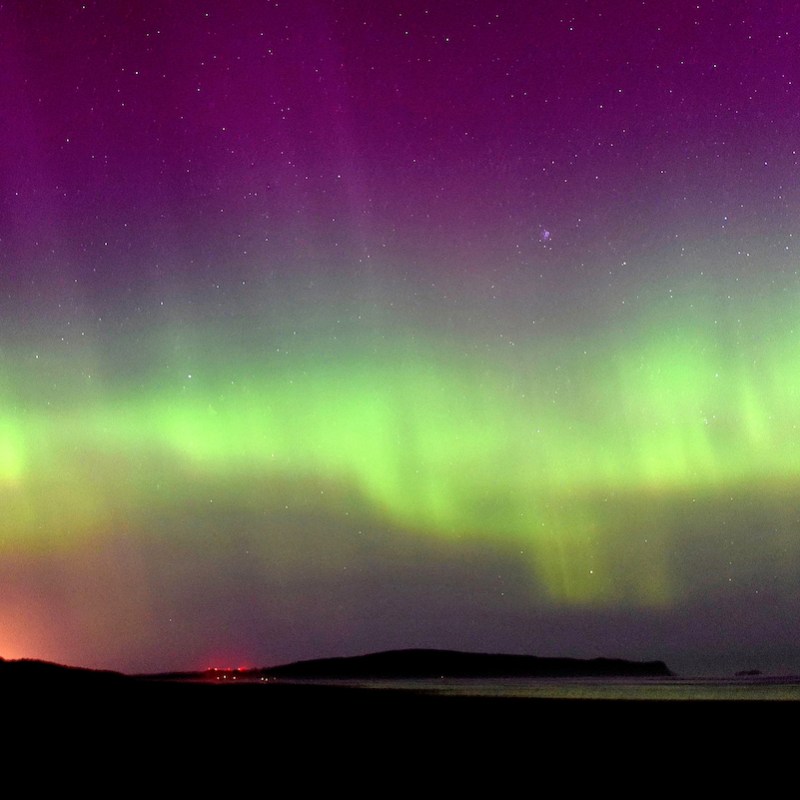
Northern lights (aurora borealis) are like, as many have put it, “a celestial ballet of light dancing across the night sky.” But reserve some of your applause for their southern belle cousins, aurora australis, or the southern lights, who put on an equally dazzling performance.
Videos by TravelAwaits
I think of auroras as pole dancers rather than ballerinas, with their wispy red, green, and purplish-blue lights shimming and dipping around the Earth’s geomagnetic Poles.
Near the North Pole, tourists see this performance in Canada, Alaska, Greenland, Norway, and Russia on land stretching deep into the Arctic Circle. On the other side of the globe, the southern lights cluster around the South Pole on Antarctica, meaning aurora australis is usually seen only by penguins and scientists.
While Antarctic penguins have prime real estate to see the southern lights directly over their heads, the southern coast of Australia and New Zealand also offer sightings, as well as being warmer and more hospitable places to holiday.
Unlike the Northern Lights, which are subject to seasonal light changes, it’s possible to see the southern lights year round. Southern auroras arrive on the horizon — their colors are more subtle than their northern counterparts yet achingly beautiful, and their dance is glorious.
Southern lights appear throughout the year but are easier to spot during the fall and winter months in the Southern Hemisphere, from March through September. In addition, auroral activity increases, and therefore, so do sightings during the equinoxes in March and September.
For opportunities to see the southern lights, simply travel as far south as your itinerary permits.

1. Tasmania, Australia
The island state of Tasmania is so far south that Hobart, Tasmania‘s capital, is a launch point for polar expeditions and offers Antarctic attractions.
Seeing the southern lights isn’t a commercialized experience. There aren’t any southern lights tours. It’s possible to see aurora australis from anywhere in Tasmania, and the experience is open to all. Choose a dark night, move away from light pollution, and ensure you have a clear view to the south. Look slightly to the right of the Southern Cross — most locals can point it out to you.
Factors outside your control include solar activity, the phases of the moon, and cloud cover. To maximize your chances, use the Bureau of Meteorology aurora page (updated every 15 mins), the Aurora Forecast app for alerts, and the Aurora Australis Tasmania Alert NOW for real-time sightings. Tasmania has a maximum length and width of about 200 miles so a viewing site might be nearby.
Pro Tip: Eco-travel agencies such as Tasmanian Odyssey help visitors customize holidays to maximize the chance of sightings.

2. Mount Wellington, Hobart
Mount Wellington is a 4,100-foot peak directly behind Hobart. The mountain’s summit offers wide-horizon views from a glass shelter, viewing platforms, and a wheelchair-accessible path. Hobart’s light pollution can weaken aurora sightings but adds an interesting effect to the bottom of a photo. The drive up to the steep summit takes 30 minutes. It can be summer below and snow on the peak. As a consolation prize, even if you don’t see an aurora, the views are amazing. Mount Nelson Lookout is also a suitable viewing site.
Pro Tip: Local aurora chasers prefer non-touristy areas on the South Arm Peninsula, about 25-miles southeast of Hobart. Clifton Beach, Calvert’s Beach, and Goat’s Bluff Lookout are notable spots.

3. Cradle Mountain, Cradle Mountain-Lake St Clair National Park, Tasmania
Cradle Mountain is an area of exceptional natural beauty in the heart of the Tasmanian Wilderness World Heritage Area. The park offers a world-class system of walking tracks, from easy strolls to the legendary Overland Track, a 5- to 6-day hike. The national park is also a spectacular place to see the aurora australis. The star-studded night skies make for amazing night photography, and the series of flat, mirrored lakes become a scenic backdrop for the southern lights. Head to the still waters of Cradle or Dove Lake for a great viewing experience.
Pro Tip: Peppers Cradle Mountain Lodge or the Pumphouse Point are stylish wilderness retreats inside the park. Book well in advance.

4. Bruny Island, Tasmania
Reach Bruny Island via a short drive (and ferry trip) from Hobart. Bruny is the size of Singapore, but with a sparse population. The island offers another of Tasmania’s amazing wilderness experiences. See wildlife, including albino wallabies, quolls, pademelons, fairy penguins, sea eagles, and albatross. There are many beaches and a rural vibe. For views of the southern lights, climb the stairs at The Neck and point your camera southward. This camera pointing is key, as cameras can pick up sightings of the southern lights before the naked eye. Bruny also offers an extensive food scene — including berries and whiskey wine. Bruny Island Cheese Co and the Bruny Island Chocolate Factory are must-visits.
Pro Tip: Glamping or free camping available. Four walls might be better in winter. Book a Vbro.

5. Cape Schanck, Mornington Peninsula, Victoria
The Australian state of Victoria is separated from Tasmania by Bass Strait. There are many spots along Victoria’s 1,200-mile coastline with dark skies and little light pollution. Known as Melbourne’s playground, the Mornington Peninsula offers wineries, country drives, hot springs, beaches, and galleries. On the southernmost tip, Cape Schanck is a popular spot to photograph auroras. Rug up and chat to locals about all things photography. Visit Cape Schanck Lighthouse earlier in the day to take in the Bushrangers Bay Nature Walk, or climb up to Pulpit Rock at the tip of the cape.
Pro Tip: For the magnificent views of the rocky coastline and Bass Strait, head to the Blowhole Lookout, between Flinders and Cape Schanck. Flinders is another good spot for southern lights photography.
6. Phillip Island, Gippsland, Victoria
About two hours from Melbourne lies Phillip Island, another spot for chasing auroras. A popular holiday destination, you’ll need to move away from the crowds to the southern areas where there are lower levels of light pollution. These ruggedly beautiful areas include Churchill Island Marine National Park, Nobbies Centre, and Phillip Island Nature Parks. By day, explore the Bass Strait beaches and visit a koala conservation center. Phillip Island is popular with overseas tourists because of the famous penguin parade, a natural phenomenon made increasingly touristy over the years. As a local, perhaps I have become somewhat jaded about the event. See our story Meet Australia’s Fairy Penguins for a more enthusiastic response.
7. Wilsons Promontory, Gippsland, Victoria
Wilsons Promontory National Park is a standout southern lights observation spot because of its southerly location. A three-hour drive from Melbourne, the “Prom,” as we call it, is for those who love natural adventures such as camping, beaches, hiking, stargazing, and auroras. The pitch-black skies make for the perfect spot. The park caters to avid hikers and those with reduced mobility,offering step-free walks and fully accessible cabins.
Pro Tip: It’s best to stay overnight rather than try a day trip. Book accommodations well in advance. Going to the Prom is almost a right of passage for most Victorians, so it gets busy in peak season.
8. The Great Ocean Road, Victoria
The famous Great Ocean Road is punctuated by medium-sized towns such as Lorne and Apollo Bay and smaller coastal hamlets. To see auroras, stay in one of the smaller towns where there’s less light pollution. Anglesea is a good choice as it has the undeveloped Anglesea Heath on one side and Port Addis Marine National Park on the other. Aireys Inlet further southwest has limited light pollution. Iconic attractions along the Great Ocean Road, such as the 12 Apostles, are wild, windswept places with viewing platforms. It’s quite possible to take a photo of an aurora over one of these attractions.

9. Lake Tekapo, Mackenzie Basin, New Zealand
New Zealand’s south island scenery will take your breath away in the daytime. But much also happens under the canopy of darkness. The small town of Lake Tekapo is New Zealand’s center for astro tourism. Significantly, the town lies under the Aoraki Mackenzie International Dark Sky Reserve, the largest dark reserve in the Southern Hemisphere. The Mt. John Observatory offers visitors access to powerful telescopes. Tours include the two-hour Tekapo Star Gazing experience to soak up aurora sightings from a steamy hot pool in Tekapo Springs.
Pro Tip: Queenstown, a major tourist hub and a center for adventure tourism in NZ has a Facebook group dedicated to local aurora sightings. This area has more than its fair share of sightings.
10. Otago Peninsula, Dunedin, New Zealand
The Otago Peninsula is a long finger of land pointing out near Dunedin. During the day, it’s an incredible place to see wildlife in their natural habitat, including sea lions, penguins, and albatross. At night, it’s a tranquil place for stargazing and watching for auroras. Aurora shots are often framed by hills and bodies of water, causing reflections that are particularly striking for keen photographers. There’s an Aurora Alert webpage for the area. Dr. Ian Griffin, a local expert, recommends Hoopers and Papanui Inlet on the Otago Peninsula as some of the best viewing spots.
Pro Tip: Stay on the Otago Peninsula to maximize your chances of seeing the southern lights. I can recommend Lanarch Castle, New Zealand’s only castle accommodations.
11. Stewart Island/Rakiura, Tasmania
Stewart Island/Rakiura is the southernmost Dark Sky Sanctuary in the world, reachable via a 20-minute flight or a one-hour ferry ride from Invercargill. Rakiura Island National Park encompasses 85 percent of Stewart Island, and visitors come for nature, hiking, elusive kiwi sightings, stargazing, and aurora sightings. Rakiura means “the land of the glowing skies,” a promising sign! On a good auroral night, there are even sightings from a lookout near the center of Oban, the main town. Twinkle Dark Sky Tours offers equipment for viewing the solar system and the larger cosmos to increase your chances.
Pro Tip: Seeing the southern lights directly overhead isn’t just for penguins. Board a commercial aurora-chasing flight that loops toward Antarctica. There are equinox departures from Christchurch in New Zealand and Melbourne in Australia. In addition, Chimu Adventures offers flights departing from most Australian capital cities.
Related Reading:
